| Reviews & Columns |
|
Reviews DVD TV on DVD Blu-ray 4K UHD International DVDs In Theaters Reviews by Studio Video Games Features Collector Series DVDs Easter Egg Database Interviews DVD Talk Radio Feature Articles Columns Anime Talk DVD Savant Horror DVDs The M.O.D. Squad Art House HD Talk Silent DVD
|
DVD Talk Forum |
|
|
| Resources |
|
DVD Price Search Customer Service #'s RCE Info Links |
|
Columns
|
|
|
Sweeney Todd - The Demon Barber of Fleet Street (Steelbook)
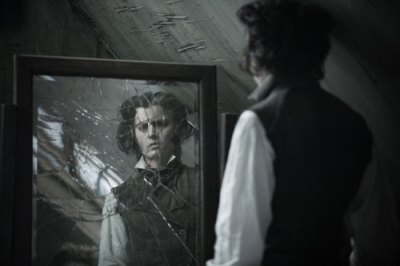
I guarantee you the closest shave you'll ever know."
-Sweeney Todd (Johnny Depp)
In 1979, acclaimed composer and lyricist Stephen Sondheim premiered his newest work, entitled Sweeney Todd: The Demon Barber of Fleet Street. The musical was complex, dark, and closer to opera than your classic Broadway musical. The show required a lot of the audience, and initial reactions were less than positive. And yet, the production has grown in esteem and popularity. Director Tim Burton enjoyed the piece from its original debut, to the point where it became his favorite musical. As he put in the liner notes to the soundtrack CD for the film, he felt the character of Sweeney Todd was on the level of a classic Universal monster. And given the success Burton has had of late with pre-existing material (the delightful Charlie and the Chocolate Factory leaps to mind), it only made sense that he try to tackle such heady material.
Sweeney Todd: The Demon Barber of Fleet Street tells the tale of the titular barber, formerly Benjamin Barker (Johnny Depp), banished from London for fifteen years by the lustful Judge Turpin (Alan Rickman). Turpin is after Barker's wife, Lucy (Laura Michelle Kelly), and after raping her, steals their daughter, Johanna (Jayne Wisener). Barker returns to London as Sweeney Todd, a man hellbent on revenge. He takes up residence in his old flat about the pie shop of Mrs. Lovett (Helena Bonham Carter), who has an infatuation with Todd. A friend of Todd's, Anthony (Jamie Campbell Bower) notices Johanna at her window, and despite being beaten by the Judge and his assistant, Beadle Bamford (Timothy Spall), vows to steal her away and elope. Todd uses this to his advantage in a plot to lure the judge into his clutches, while Mrs. Lovett tries to convince Todd that all they need is each other. And there's also a lot of murder, cannibalism, child abuse, and plenty of other politically incorrect goings on.
Despite the seemingly natural pairing of a brooding visualist like Burton and the richly dark content of Sondheim's groundbreaking musical, but in truth it was a very bold move on Burton's part. Despite including musical numbers in Charlie and the Chocolate Factory, this was the first time that he would be making a film where the music not only played continuously throughout the picture, but also propelled the plot and focused the narrative. It helps that Sweeney Todd: The Demon Barber of Fleet Street has more depth than almost any other musical on the planet, and this stems from the genius of Stephen Sondheim.
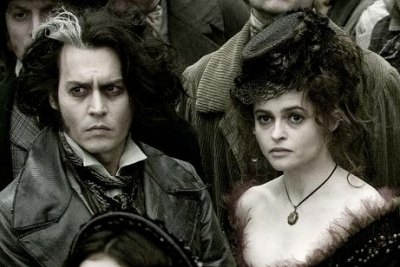
Sondheim is perhaps the best-known American musical composer, having won seven Tony Awards, an Academy Award, many Grammys, and a Pulitzer Prize. Many of his works have become standards of the format, including A Little Night Music, Sunday In The Park With George, and Into The Woods. He's written material in a variety of different styles, proving himself time and time again as a master of melody and construction. Sweeney Todd is probably his most compositionally complex work, with a lot of counterpoint and angular harmonies. He's fond of overlaying different parts on top of each other, both musically and vocally. The show is constructed using many leitmotifs, recurring musical themes that pop up in different configurations throughout the runtime. The music is so ambitious and expansive that the show has often been compared to opera.
The songs in Sweeney Todd are not your typical toe-tapping tunes. There are a lot of half-steps and off rhythm notes, giving the score a disorienting feel. However, Sondheim smartly makes the melodies lush and memorable. That doesn't mean the music is immediately accessible. Far from it. Many people, especially those who grew up on the regular 4/4 rhythms of rock, find the atypical numbers to be quite off putting, to the point of labeling them rambling and poorly written. But for those willing to invest the time to study the music and gain a larger appreciation for it will find some of the richest compositions in the musical milieu.
In addition, Sondheim's reputation as a lyricist is also sterling. And despite the brooding nature of the material, Sweeney Todd has a lot of sharp humor. Much of this centers around the character of Mrs. Lovett, who is introduced to the audience by singing about how her pies are "The Worst Pies In London," where she decries how hard times are that a rival pie maker, Mrs. Mooney, steals the local cats to fill her pastries. Of course, Mrs. Lovett would never do such a thing...but by god those cats are quick. Or the centerpiece of the musical, "A Little Priest," where Todd and Mrs. Lovett, having hatched a scheme to cook the victims of Todd's lethal shaves, describe how each different class of person would taste. Each type of person is ridiculed by the pair as they relate how someone's behavior would affect the way they taste. For example, a priest "Doesn't commit sins of the flesh/So it's pretty fresh." And they note how "Lawyer's rather nice/If it's for a price" but you had better "Order something else, though, to follow/Since no one should swallow it twice!" Mrs. Lovett goes so far as to offer "Shepherd's Pie peppered with actual shepherd" and the two finish the number by declaring they will "Serve anyone/Meaning anyone/And to anyone/At all!" The humor provides a counterpoint for the darkness just as the voices of the actors counterpoint their vocal melodies.
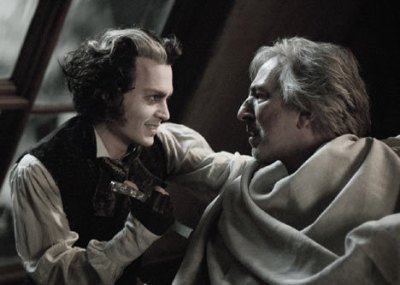
And this brings us to the cast. Burton made the decision to cast people without proper musical training to play the roles, wanting the actors to worry more about the emotions than the music. That doesn't mean the film ignores the importance of the songs. The cast all took extensive singing lessons to hit the difficult notes, and while not every one of them sounds like they could become professional singers, they all carry their parts with such conviction that the performances are exactly what Burton wanted. Leading the charge is Johnny Depp in the title role. I've seen Sweeney Todd on stage and, due to the nature of theater, the character is much more extroverted, playing out his revenge fantasies out loud for the audience to see. Depp goes the opposite route, giving us the most introspective and internal portrayal of Todd ever seen. It's a nice change of pace, after playing the kooky Captain Jack Sparrow in the Pirates of the Carribean films, to play a character who spends so much time mulling in silence, only to explode with intense violence.
Helena Bonham Carter steals the show as Mrs. Lovett. Despite being a much more outgoing character than Sweeney Todd, she also has the most immediately memorable and funny songs. From "The Worst Pies In London" to "By The Sea," she is the gateway for the audience to enter the world of Sweeney Todd. Even as she cooks men into meat pies, she has a devil may care attitude that puts viewers at ease, and even lets them identify with her, despite her gruesome deeds. Alan Rickman appears as Judge Turpin, and while his role is significantly shortened from the stage version, he still has the kind of presence that makes you hold your breath when he's in the same room as Todd. And then you've got supporting actors like Timothy Spall and Sascha Baron Cohen who help round things out, making sure even the tertiary characters have personality.
Tim Burton is best known for his arresting visuals, from the bureaucratic afterlife of Beetlejuice to the gorgeous hedge sculptures of Edward Scissorhands and the wild architectural metropolis of Batman. His view of London during the Industrial Revolution is rank and dark. Sweeney Todd is the most stark film of his career, with pure black shadows contrasting against the powdery white of the characters' skins. But Sondheim's brilliant writing allows Burton to focus on the visuals while never losing sight of the narrative thrust. He creates a thrilling Gothic atmosphere in which Todd and Mrs. Lovett can play. And when Sweeney Todd takes another victim, Burton doesn't shy away from the gore, reveling in the modern day Grand Guignol. He never overplays his hand, keeping the audience on edge whenever Sweeney pulls out his razors.
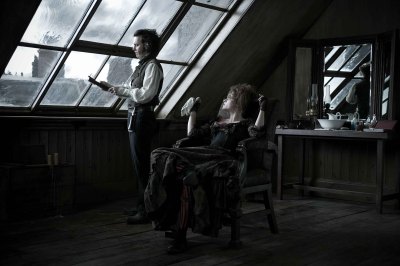
Burton collaborated with Sondheim in condensing the material to work on film. This has resulted in the expulsion of several numbers, including the seemingly vital opening, "The Ballad of Sweeney Todd," and "Johanna (Judge's Song)," which gives the audience more insight into the motivations of Judge Turpin. Burton also condensed several songs, such as "God, That's Good!" and "A Little Priest," whittling them down to their most essential elements. Surprisingly, almost all of the changes work perfectly, narrowing the focus down to Todd and his obsession. Also, in removing some of the melodies, Burton brings out the film-like nature of the underscore, which Sondheim himself says was heavily influenced by famed film composer Bernard Herrmann. While some great songs are gone, it's a new vision of Sweeney Todd that may infuriate purists, but will more than satisfy those with an open mind.
In truth, Sweeney Todd is Burton's best film since Ed Wood, and perhaps the best movie he's ever made. It contains all the hallmarks of his style while telling a tight and horrific tale of revenge. There's an incredible maturity in the telling, with the gore feeling like a necessary outpouring of emotion, rather than a mode of cheap titillation. Burton is confident, and working with the definitive master of American musical theater. It's stylish, it's beautiful, it's horrific, and it's undeniably great. I can't wait to see where Burton goes from here.
The Blu-ray disc:
Warner Bros. released Sweeney Todd internationally, and when Paramount made the baffling decision to not announce Sweeney with its batch of "make-up" Blu-rays (films that could have been released in the waning days of HD DVD but weren't, including There Will Be Blood, Bee Movie, and Cloverfield), Warner's region-free UK Blu-ray release became the easiest way to get the film in high definition. It doesn't hurt that the disc is housed in an attractive steelbook casing (pictured above the disc ratings). Note that high definition content doesn't have the same issues going from country to country as standard video does, because HD is a single standard, versus the differing worldwide standards for standard definition. Also, this disc is region free and will play in any Blu-ray player in the world.
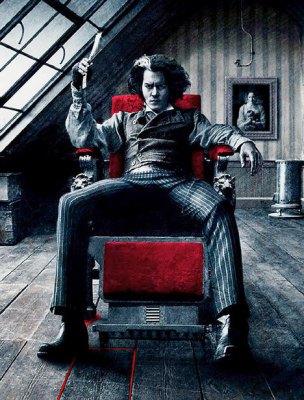
The Image:
Warner Bros. presents Sweeney Todd: The Demon Barber of Fleet Street in its original theatrical aspect ratio of 1.85:1 in a 1080p AVC-encoded transfer. While the opening, where the ship comes into port after the credits, is literally crawling with grain, to the point where it may be more than what we saw in the theater, the vast majority of this transfer is spectacular (I received an email from Robert Harris, world renowned film restorationist, who explained that this was most likely due to the film grain being slightly smoothed out during the transfer from the digital intepositive to celluloid, while the Blu-ray transfer would have been taken directly from the DI, thus retaining all the grain). Sweeney Todd has some difficult imagery that utterly defeated the DVD, but the Blu-ray has no such problems. In particular, I checked the scene where Mrs. Lovett first brings Sweeney back to his flat above the pie shop and presents him with his razors. The DVD is littered with mosquito noise and other artifacts. The Blu-ray offers a clean, crisp image devoid of any compression hiccups. And even leaving the DVD comparisons aside, this disc still presents a top notch high definition image. The color reproduction is spot on, with the disc ably handling the steely blues, the ashen greys, and the bloody reds and oranges. Detail is also much improved. You can now make up the small lines in Helena Bonham Carter's face, the grime underneath Alan Rickman's fingernails, and all the minutiae of the set design. A stunner if I ever saw one.
The Audio:
Warner Bros. offers a lossless Dolby True HD 5.1 mix for this Blu-ray, and it's about time. I can't think of a better candidate for lossless sound than Sweeney Todd, and this track doesn't disappoint. While it doesn't hide the fact that the actors' singing voices were re-recorded in the studio (in fact, the lossless nature makes it all the more evident, by making audible the aural differences between the on-set sound and the studio sound), but in all other aspects it shines. The mix is bold and enveloping, right from the first moments, as the heavy organ fills the soundstage. The dialogue and vocals are never overshadowed by the music, and there were plenty of surprising trills coming from the surround speakers. The bass is also excellent, although used more for the brass than it is for effects on screen.
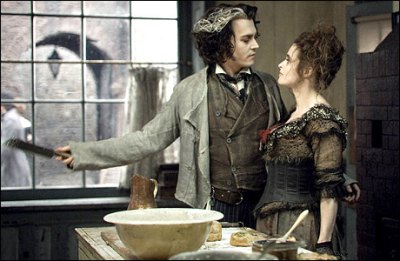
The Supplements:
Warner Bros. ports over almost all of the features from the two-disc DVD (absent is the Moviefone interview with Burton and Depp, and, as far as I can tell, the trailer), and aside from the HBO First Look and the Press Conference, all of them are in 1080i high defintion. And despite being an import disc, the standard definition video played just fine on my PS3.
- Burton + Depp + Carter = Todd: A 25-minute behind the scenes documentary, using a mix of interviews, behind the scenes footage, and photos. As the title would suggest, the main commentators are Tim Burton, Johnny Depp, and Helena Bonham Carter, but we also get some choice words from Stephen Sondheim and Alan Rickman, among others. The interviews are far more candid and in-depth than the standard promotional fare, and the behind the scenes footage is fascinating, as we watch how difficult it is for the actors to act while singing. There's also footage of the cast recording their vocals in a recording studio.
- Sweeney Todd Press Conference: A very funny and engaging twenty minute press conference. Tim Burton, Johnny Depp, Helena Bonham Carter, Alan Rickman, Timothy Spall, and Richard Zanuck all participate, answering questions ranging from insightful to inane, but all with good humor. An excellent companion to the documentary.
- Sweeney Todd is Alive - The Real History of the Demon Barber of Fleet Street: A decent documentary on the origins of the Sweeney Todd story and its basis in fact. A cross section of experts give their opinions (which range from certainty that a real Todd existed to certainty that a real Todd did not exist), and there's a lot of interesting crimes detailed by real people who likely influenced the legend of Sweeney Todd.
- Musical Mayhem - Sondheim's Sweeney Todd: This is mostly an interview with Sondheim about the origins of his musical. It then expands to discuss his role in the making of the movie, and the changes made to the score for the film. He's very happy with the results, and being able to work with Burton.
- Sweeney's London: A look at London before and during the Industrial Revolution. Many of the experts from the "Sweeney Todd is Alive" documentary reappear here, and while the focus is less on Todd, there's a lot of interesting period drawings.
- The Making of Sweeney Todd: This, unfortunately, is the generic promo piece you've come to expect from DVD special features. A lot of brief, inconsequential comments to be found, and much of the material is found elsewhere on the set.
- Grand Guignol - A Theatrical Tradition: A look at the Grand Guignol, a real theater in France that was active from 1897 to 1962. The term "Grand Guignol" has come to encompass a lot of horror entertainment. The documentary focuses more on the style than the original theater. It certainly sheds light on one of Burton's (and Sondheim's) influences.
- Designs For A Demon Barber: Frequent Burton collaboraters Colleen Atwood and Dante Ferretti are the subjects of this special feature, which focuses on the look of Sweeney Todd. Some good interviews with the two and Burton, along with beautiful design drawings.
- A Bloody Business: A great little feature on the film's prosthetics for each of Sweeney's victims. This is almost entirely comprised of behind the scenes footage from the effects workshop, including portions where Burton throws out ideas and Depp watches on in the background, in full Sweeney costume. A lot of gory fun.
- The Razor's Refrain: A collection of stills from the film and the shoot, set to a medley of music from the movie.
- Photo Gallery.
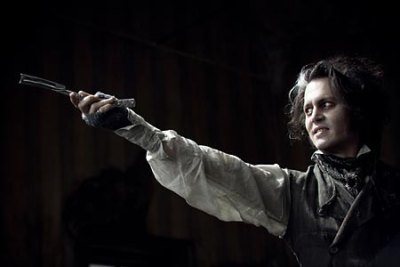
The Conclusion:
Sweeney Todd: The Demon Barber of Fleet Street is an artistic leap forward for director Tim Burton, and also happens to be one of the best film musicals yet made. Stephen Sondheim's genius music and lyrics are perfectly matched with Tim Burton's impeccable visual style, and the whole thing is performed with gusto by Johnny Depp and Helena Bonham Carter. It's an important and vital film. The image quality is such a large improvement over the DVD that it alone makes the disc worth a purchase, but the sound is also tremendous, and almost all of the special features from the two-disc set are present, with all but two extras in high definition. While some may be hesitant to shell out $40, this disc is worth it, and there's a non-Steelbook edition available for slightly less. Now, how about a shave? DVD Talk Collector Series.
The images in this review do not reflect the quality of the Blu-ray disc.
Daniel Hirshleifer is the High Definition Editor for DVD Talk.
|
| Popular Reviews |
| Sponsored Links |
|
|
| Sponsored Links |
|
|
| Release List | Reviews | Shop | Newsletter | Forum | DVD Giveaways | Blu-Ray | Advertise |
|
Copyright 2024 DVDTalk.com All Rights Reserved. Legal Info, Privacy Policy, Terms of Use,
Manage Preferences,
Your Privacy Choices | |||||||











